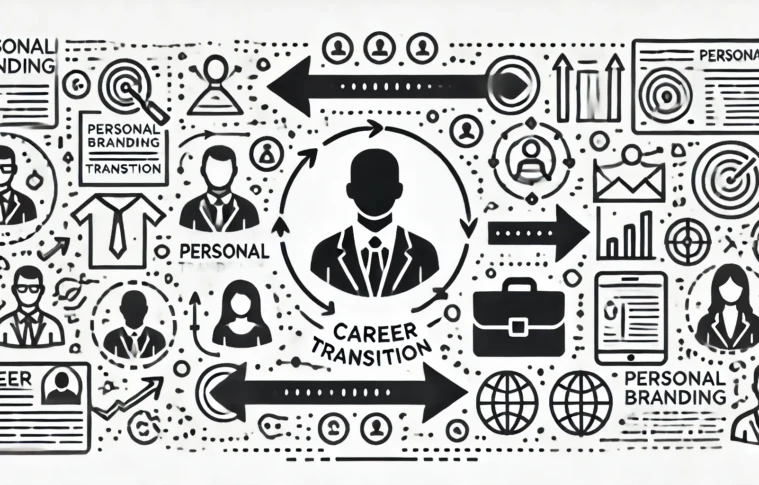In today’s ever-evolving job market, switching careers has become increasingly common. However, a successful career transition is rarely just about updating your resume or learning new skills. It’s also about effectively communicating your unique value and positioning yourself as a strong candidate in your new field. This is where personal branding comes in. By leveraging a well-crafted personal brand, you can create a bridge from your current career to your new path, showcasing the skills, values, and experiences that make you an ideal fit for your target industry.
In this blog, we’ll explore how to use personal branding to make a seamless and impactful career transition, guiding you through key steps to help you stand out and succeed.
1. Define Your New Career Goals and Personal Brand Direction
Before diving into personal branding, it’s crucial to have a clear understanding of your new career goals. Knowing exactly where you want to go allows you to align your personal brand with the expectations and demands of your target industry. Defining your goals will also help you identify which skills and experiences are most valuable in this new context.
Steps to Define Your Career Goals:
- Research the Industry: Study the trends, challenges, and skills in your desired field to understand what employers and professionals prioritize.
- Identify Key Competencies: Determine which skills from your current role are transferable and relevant in your new field.
- Set Specific Goals: Outline what you aim to achieve in your new career, such as specific roles, companies, or areas of expertise.
Example: If you’re transitioning from marketing to UX design, focus on how your user experience skills in marketing can enhance your approach to designing user-centric digital products.
2. Identify and Leverage Transferable Skills
One of the most effective ways to rebrand yourself for a new career is by highlighting transferable skills—those skills that apply across multiple industries. These can include abilities like project management, leadership, problem-solving, communication, and any industry-specific expertise that might also be valued in your new field.
How to Showcase Transferable Skills:
- Create a Skills Inventory: Make a list of your most valuable skills, both technical and soft, and identify which ones align with your new career path.
- Use Specific Examples: When updating your resume, LinkedIn, or online profiles, highlight how you’ve successfully used these skills in the past.
- Tell a Story: Position your skills in a way that reflects your journey and readiness for a new role. Share stories about times you solved a problem, managed a project, or improved a process in a way that’s relevant to your target industry.
Example: A project manager transitioning into HR could showcase their organization, team management, and communication skills as foundational to success in a human resources role.
3. Update Your LinkedIn Profile and Online Presence
As a central part of your personal brand, your LinkedIn profile should reflect your career transition goals. Update your profile to reflect your new direction, making it clear that you are actively pursuing opportunities in a different field. Remember that your online presence isn’t limited to LinkedIn; ensure any other public profiles align with your new career goals.
Tips for Updating Your LinkedIn Profile:
- Update Your Headline: Instead of your current job title, use your headline to reflect the role or industry you’re targeting, such as “Aspiring Data Analyst | Experienced Problem Solver” or “UX Designer | Transitioning from Marketing with User-Centric Focus.”
- Craft a Compelling Summary: Write a summary that emphasizes your transferable skills, passion for the new field, and any recent projects or training that showcase your commitment.
- Highlight Relevant Skills and Accomplishments: Showcase skills, achievements, and endorsements that will resonate in your new career path.
Pro Tip: Join and engage in LinkedIn groups related to your new industry. Sharing relevant content or contributing insights helps establish your credibility in your target field.
4. Build a Portfolio or Showcase Your Work
If you’re transitioning into a field that values hands-on experience and results (e.g., UX design, content creation, data analysis), building a portfolio can be incredibly valuable. Portfolios are a tangible way to demonstrate your expertise, highlight relevant projects, and showcase the skills you bring to the table.
Ideas for Building Your Portfolio:
- Include Transition Projects: Work on projects related to your new field, even if they’re self-initiated, and add these to your portfolio.
- Add Testimonials: Collect recommendations from colleagues or clients that speak to your transferable skills, adaptability, and work ethic.
- Keep it Professional: Use a clean, professional layout and ensure that your portfolio reflects the industry you’re moving into.
Example: An engineer transitioning to data science could create a portfolio featuring data-driven projects, highlighting their technical problem-solving skills with real-world examples.
5. Create Content to Build Authority in Your New Field
Content creation is a powerful tool for establishing your personal brand, particularly if you’re making a career transition. By creating and sharing content related to your new field, you demonstrate your knowledge and dedication, helping to build credibility and familiarity within the industry.
Content Ideas for Career Transitions:
- Write Blogs or Articles: Share your insights, perspectives, or findings on trends in your target industry. Blogging on platforms like LinkedIn or Medium can make your knowledge visible to a wider audience.
- Share Your Journey: Write about your career transition, what you’re learning, and how you’re adapting. Documenting this process can resonate with others and provide inspiration for people on a similar path.
- Create a Personal Website: A website is a great place to house your portfolio, blog, resume, and contact information in one cohesive space that reflects your brand.
Pro Tip: Engage with industry-specific content by commenting on or sharing articles from leaders in your target field. This shows you’re actively involved and learning about the industry.
6. Network Strategically with People in Your Target Field
Networking is crucial in any career, but especially so when you’re transitioning. Building connections within your target industry can provide insights, mentorship, and even job leads that help you succeed.
Networking Tips for Career Changers:
- Reach Out to Industry Professionals: Find people in your target industry on LinkedIn, join industry groups, or attend virtual events to meet potential mentors and colleagues.
- Request Informational Interviews: Approach professionals in your new field and ask for informational interviews to gain insights and advice. This can also be a great way to establish relationships without the immediate pressure of seeking employment.
- Attend Relevant Industry Events: Industry events and conferences are valuable opportunities to learn about the field, meet others, and make a positive impression.
Example: If you’re moving from finance to tech, attend tech meetups, join relevant LinkedIn groups, and connect with people who share insights about the tech landscape.
7. Demonstrate Your Growth and Adaptability
Employers are drawn to candidates who demonstrate resilience, adaptability, and a willingness to learn. Transitioning careers requires each of these qualities, so let them shine through in your personal brand.
How to Showcase Adaptability and Growth:
- Highlight Continuous Learning: Take courses, earn certifications, or complete training programs relevant to your new field. Include these on your LinkedIn profile and resume.
- Share Stories of Problem Solving: When discussing your past experience, focus on times you solved challenges or took on unfamiliar tasks. These experiences showcase your flexibility and determination.
- Embrace Your Unique Background: Use your background as an asset. Emphasize how your past experience offers a fresh perspective or unique skills in your new industry.
Pro Tip: For every skill gap you identify, work on building a new skill or credential that can fill it. This shows commitment to your new path.
8. Seek Testimonials and Recommendations
Social proof is invaluable when building a personal brand. Positive testimonials from colleagues, mentors, or clients can be especially helpful when transitioning careers, as they reinforce your credibility and trustworthiness.
Tips for Gathering Testimonials:
- Request Recommendations on LinkedIn: Ask former colleagues or clients for recommendations that focus on skills you’ll bring to your new role.
- Feature Testimonials in Your Portfolio: If relevant, add testimonials to your portfolio or personal website to show others’ confidence in your abilities.
- Ask for Feedback on Transition Projects: If you’ve done freelance or pro bono work in your target industry, request feedback and share these recommendations on your profiles.
Example: A teacher transitioning into instructional design might include a testimonial from a school administrator about their curriculum development skills and passion for education.
Conclusion: Positioning Yourself for a Successful Career Transition
Transitioning careers is a journey that requires both patience and strategy, but by using personal branding, you can bridge the gap between where you are now and where you want to be. Focus on showcasing your transferable skills, building a portfolio, engaging in relevant content, and connecting with professionals in your target field. Remember, every skill, experience, and connection helps you stand out in your new industry.
With a well-crafted personal brand, you can present yourself as the ideal candidate for your desired role and establish yourself as a knowledgeable, adaptable professional ready to make a meaningful impact. By following these strategies, you’ll be well-equipped to succeed in your career transition and leave a lasting impression in your new field.



